Lost Churches of Romney Marsh
There are fourteen Historic Churches still standing on Romney Marsh. There were at least ten more but these have either vanished, fallen into disrepair or no longer usaed as churches. Read what is known about them here.
![]() Midley Church
Midley Church
![]() New Romney
New Romney
![]() Orgarswick
Orgarswick
![]() The Sanctuary Dungeness
The Sanctuary Dungeness

Romney Marsh in the 13th Century Showing the Lost Churches
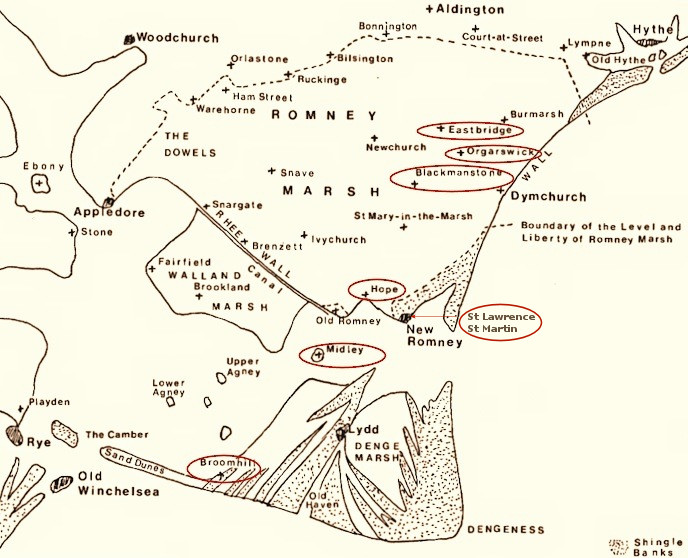

Located west of Dymchurch and adjacent to the Orgarswick Parish, Blackmanstone Church was probably built by the Saxons. Mentioned in the Domesday Book, it disappeared in the 15th/16th century.
Built on the beachy area to the west of Dungeness, Broomhill was derelict by 1590. Excavated in the 1980s, it is now merely a heap of stones near an abandoned farm house.
Mentioned in the Domesday Book, Eastbridge Church is now in ruins with just the remains of the west tower, the walls of the nave and chancel remaining. It seems to have been a handsome building, and being situated on a small rise, makes a very conspicuous object over the whole of Romney Marsh, having the appearance of a stately well-built tower, with pinnacles at the top of it. It appears to have consisted of one isle and one chancel, and to have been built of the quarry-stone. The rest of the foundations were excavated 1933
The church has been for many years in ruins. It appears to have consisted of one isle and one chancel, and to have been built of the quarry-stone.
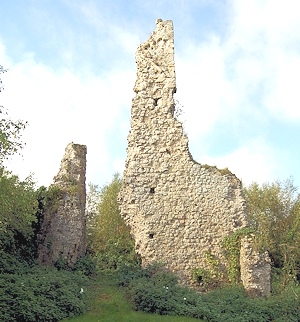
Eastbridge Church
Built in c1150 of Caen stone in the former parish of Hope, the Hope Church of All Saints fell into decay in the 17th century. During the 19th century the ruins were a favourite meeting place for smugglers. The ruins still remain are near to Ashford Road that runs from New Romney to Ivychurch.
William Holloway, in his book The History of Romney Marsh published in 1849, said of Hope "...from Old Romney once stood the village of Hope ; its chapel, which is now in ruins, is reported by traditionary lore to have been the first that was erected in Romney Marsh : it was called Hope, it is said, to express their wishes for the fixture prosperity of their newly-acquired home, and it was dedicated to All Saints,..."
![]() Hope All Saints: A Survey and Discussion of the Ruins and Earthworks
Hope All Saints: A Survey and Discussion of the Ruins and Earthworks
Sculpture and Heritage Park
There are plans to turn the site into a Heritage Park. The IMOS Foundation have recently purchased the land and have started to turn the church ruins and surrounding fields into a memorial park with 100 trees being planted and the moat around the ruins being crossed with four bridges. Find out more
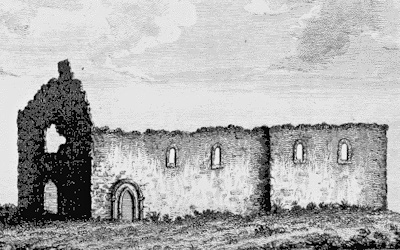
Hope All Saints Church 1799
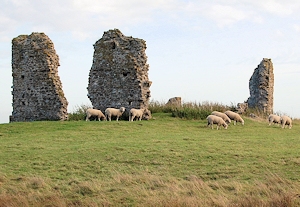
Hope All Saints Church Today
Midley Church was located on a sandbank in the river Limen/Rother than flowed north east to (New) Romney and the sea.
The Church was deserted in the 16th century and its ruins remain as a dramatic arch. The ruins can be accessed via a public footpath of the road that runs from Old Romney to Lydd.
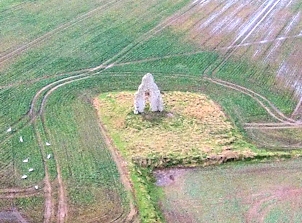
Aerial View of Midley Church
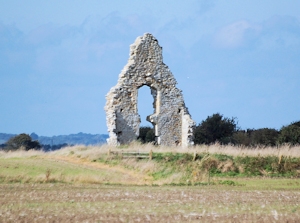
Midley Church
There were three churches in New Romney but only St Nicholas Church still remains. St Lawrence Church was a late Saxon Church thought to have been located between the present High Street and West Street. It was demolished in the mid 16th century due to the town's dimished population.
The third church was St Martins, located where St Martin's Field is now off Ashford Road. The oldest church in New Romney. St. Martin’s Church was built by the Saxons to serve what was then a fishing village. By 1550 it had fallen into a state of disrepair as the town could not afford the upkeep of both St. Nicholas’, and St. Martin’s churches. Its demolition was finally agreed by Archbishop Cranmer.
By 1282 St Nicholas had become the prime church and St Martin and St Lawrence dependent chapels.
Located north west of Dymchurch on the Eastbridge Road and and adjacent to the Blackmanstone Parish, Orgarswick Church was probably built by the Saxons.
The church disappeared in the 15th century but its location is marked by a Church Memorial Cross, which was erected in 1938.
The plaque on the base of the cross says:
AMDC - This cross was erected on the site of the ancient church of Orgarswick 1938.
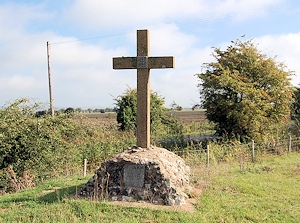
Orgarswick Church Memorial Cross
Located on Dungeness, the Sanctuary was constructed during the war as a PLUTO (Pipeline Under The Ocean) pump station to send fuel under the Channel. After 1945 the pump station was converted into a small school, with the addition of a chapel in the 1950s for local residents.
Subsequently, it became a community hall and then for twenty years a meeting lodge for the royal antediluvian order of buffaloes. Between 2014-2016, it was refurbished and converted to a private residence. The Sanctuary was dedicated by the Archbishop of Canterbury in April 1954. A plaque inside reads:
The First Sanctuary at Dungeness
Given in memory of Mildred Parnell
Wife of the Lightship Secretary of the Mission to Seaman
Dedicated by the Lord Archbishop of Canterbury for the celebration of Holy Communion
11th April 1954
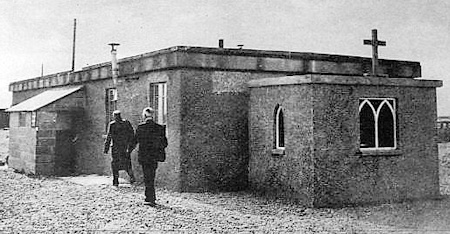
The Sanctuary c1956
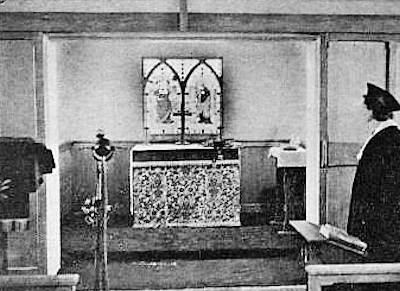
Inside The Sanctuary c1956
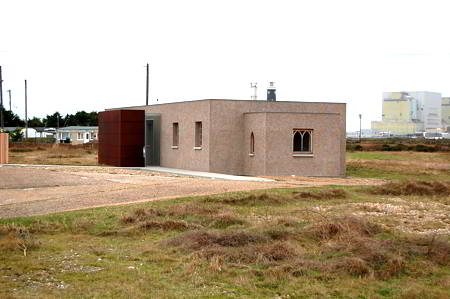
The Sanctuary Today
St Augustine Roman Catholic Church Littlestone
St Augustine Roman Catholic Church is located Queens Road in Littlestone.
Services
Sunday Masses have been cancelled until further notice. Please see here
Sacrament of Reconciliation: Before Mass
Holy Days of Obligation: 7.00pm (vigil) on the evening before Holy Day
For more information, please visit the Catholic Hythe website.
Contact
Parish Priest ![]() 01303 266420
01303 266420
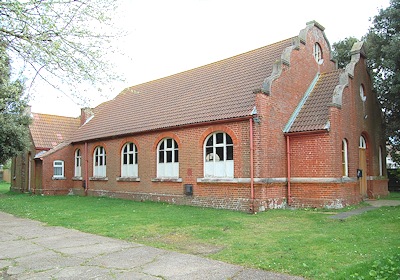
St Augustine, Littlestone
St Martin of Tours Roman Catholic Church Lydd
St Martin of Tours Roman Catholic Church is located at the south end of Lydd High Street.
St Martin’s is a simple building in a crude version of the Gothic style built in 1931. An earlier wooden chapel had been built on the site but was destroyed by fire in the early 1920s.
The plan comprises an aisleless nave with stair tower projections either side of the main front. The walls are faced with stone laid in regular courses and the roof is covered with plain tiles. The gabled west elevation has a moulded plinth from which rise four flat buttresses, curiously extended above the eaves line, which divide the front into five bays. Inside the fittings are very simple: timber benches, communion rails, altar and reredos, which probably all date from the 1930s.
Sunday Masses have been cancelled until further notice. Please see here
Holy Days: 6.00pm
Contact
Parish Priest ![]() 01303 266420
01303 266420
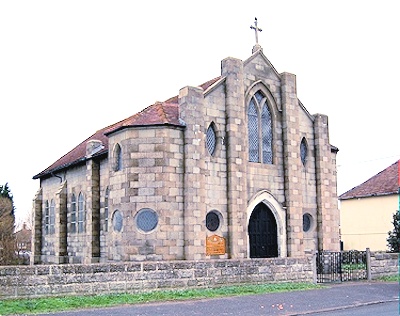
St Martin of Tours, Lydd


